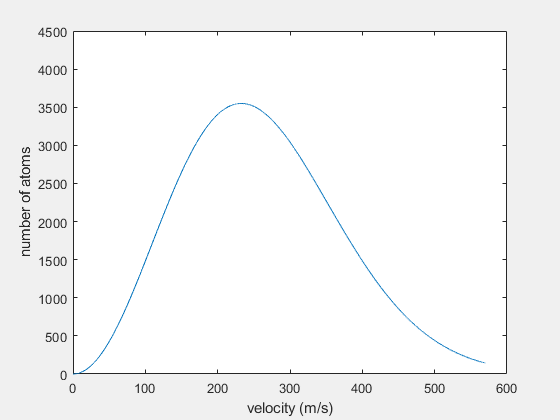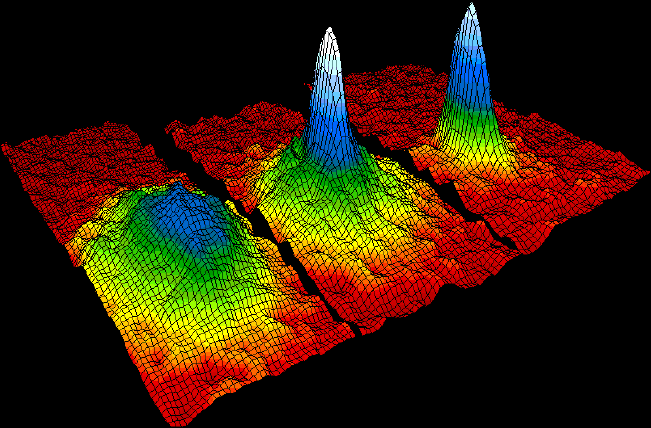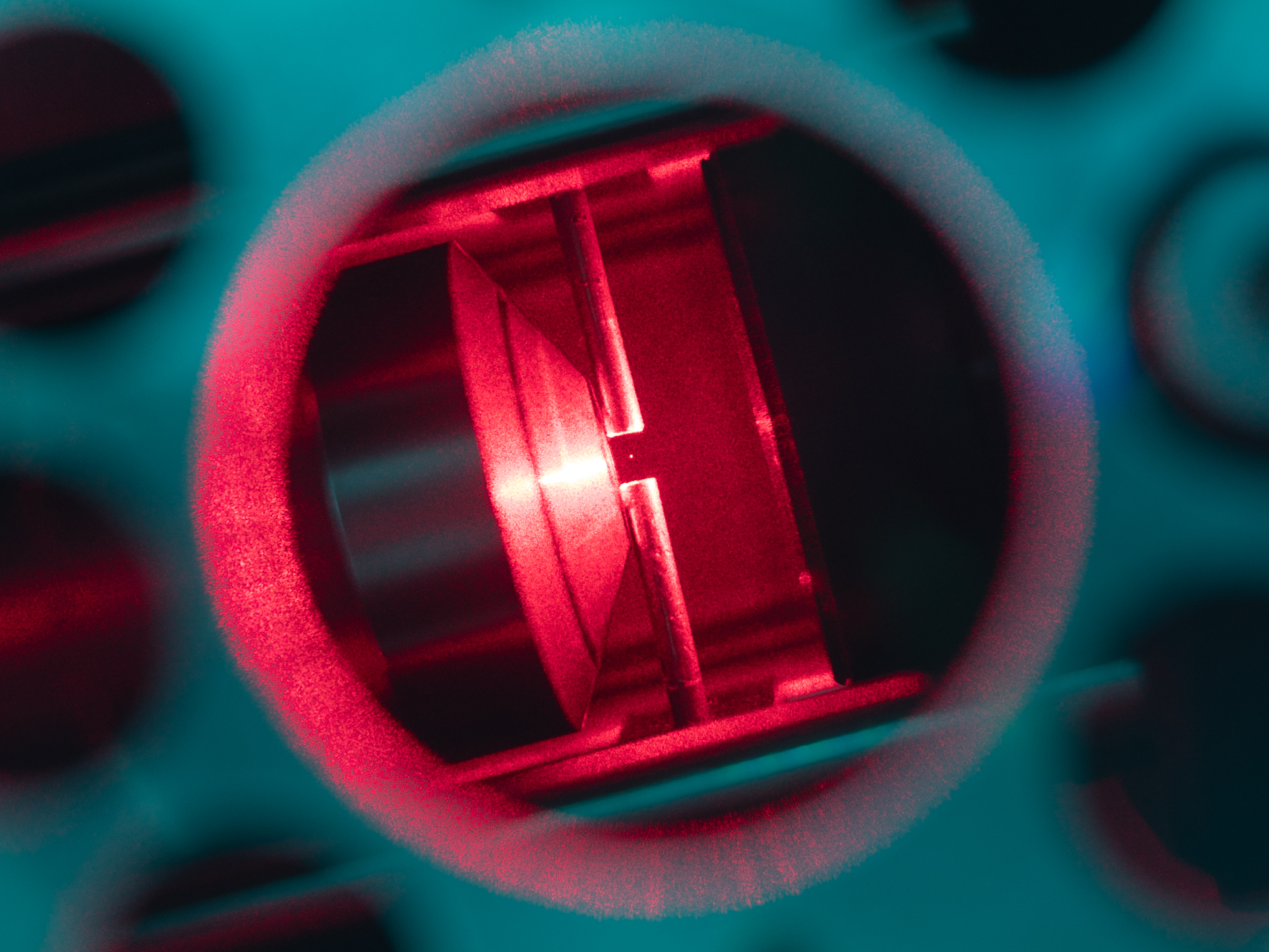|
Evaporative Cooling (atomic Physics)
Evaporative cooling is an atomic physics technique to achieve high phase space densities which optical cooling techniques alone typically can not reach. Atoms trapped in optical or magnetic traps can be evaporatively cooled via two primary mechanisms, usually specific to the type of trap in question: in magnetic traps, radiofrequency (RF) fields are used to selectively drive warm atoms from the trap by inducing transitions between trapping and non-trapping spin states; or, in optical traps, the depth of the trap itself is gradually decreased, allowing the most energetic atoms in the trap to escape over the edges of the optical barrier. In the case of a Maxwell-Boltzmann distribution for the velocities of the atoms in the trap, these atoms which escape/are driven out of the trap lie in the highest velocity tail of the distribution, meaning that their kinetic energy (and therefore temperature) is much higher than the average for the trap. The net result is that while the total trap p ... [...More Info...] [...Related Items...] OR: [Wikipedia] [Google] [Baidu] |
Thermodynamic Phase Space
The phase space of a physical system is the set of all possible physical states of the system when described by a given parameterization. Each possible state corresponds uniquely to a point in the phase space. For mechanical systems, the phase space usually consists of all possible values of the position and momentum parameters. It is the direct product of direct space and reciprocal space. The concept of phase space was developed in the late 19th century by Ludwig Boltzmann, Henri Poincaré, and Josiah Willard Gibbs. Principles In a phase space, every degree of freedom or parameter of the system is represented as an axis of a multidimensional space; a one-dimensional system is called a phase line, while a two-dimensional system is called a phase plane. For every possible state of the system or allowed combination of values of the system's parameters, a point is included in the multidimensional space. The system's evolving state over time traces a path (a phase-space tra ... [...More Info...] [...Related Items...] OR: [Wikipedia] [Google] [Baidu] |
Magnetic Trap (atoms)
In experimental physics, a magnetic trap is an apparatus which uses a magnetic field gradient to trap neutral particles with magnetic moments. Although such traps have been employed for many purposes in physics research, they are best known as the last stage in cooling atoms to achieve Bose–Einstein condensation. The magnetic trap (as a way of trapping very cold atoms) was first proposed by David E. Pritchard. Operating principle Many atoms have a magnetic moment; their energy shifts in a magnetic field according to the formula :\Delta E = - \vec \cdot \vec. According to the principles of quantum mechanics the magnetic moment of an atom will be quantized; that is, it will take on one of certain discrete values. If the atom is placed in a strong magnetic field, its magnetic moment will be aligned with the field. If a number of atoms are placed in the same field, they will be distributed over the various allowed values of magnetic quantum number for that atom. If a magneti ... [...More Info...] [...Related Items...] OR: [Wikipedia] [Google] [Baidu] |
Radio Frequency
Radio frequency (RF) is the oscillation rate of an alternating electric current or voltage or of a magnetic, electric or electromagnetic field or mechanical system in the frequency range from around to around . This is roughly between the upper limit of audio frequencies that humans can hear (though these are not electromagnetic) and the lower limit of infrared frequencies, and also encompasses the microwave range. These are the frequencies at which energy from an oscillating current can radiate off a conductor into space as radio waves, so they are used in radio technology, among other uses. Different sources specify different upper and lower bounds for the frequency range. Electric current Electric currents that oscillate at radio frequencies (RF currents) have special properties not shared by direct current or lower audio frequency alternating current, such as the 50 or 60 Hz current used in electrical power distribution. * Energy from RF currents in conduct ... [...More Info...] [...Related Items...] OR: [Wikipedia] [Google] [Baidu] |
Boltzmann Distribution Evaporation
Ludwig Eduard Boltzmann ( ; ; 20 February 1844 – 5 September 1906) was an Austrian mathematician and theoretical physicist. His greatest achievements were the development of statistical mechanics and the statistical explanation of the second law of thermodynamics. In 1877 he provided the current definition of entropy, S = k_ \ln \Omega, where Ω is the number of microstates whose energy equals the system's energy, interpreted as a measure of the statistical disorder of a system. Max Planck named the constant the Boltzmann constant. Statistical mechanics is one of the pillars of modern physics. It describes how macroscopic observations (such as temperature and pressure) are related to microscopic parameters that fluctuate around an average. It connects thermodynamic quantities (such as heat capacity) to microscopic behavior, whereas, in classical thermodynamics, the only available option would be to measure and tabulate such quantities for various materials. Biography ... [...More Info...] [...Related Items...] OR: [Wikipedia] [Google] [Baidu] |
Magneto-optical Trap
In atomic, molecular, and optical physics, a magneto-optical trap (MOT) is an apparatus which uses laser cooling and a spatially varying magnetic field to create a Magnetic trap (atoms), trap which can produce samples of Ultracold atom, cold neutral atoms. Temperatures achieved in a MOT can be as low as several microkelvins, depending on the atomic species, which is two or three times below the Recoil temperature, photon-recoil limit. However, for atoms with an unresolved hyperfine structure, such as , the temperature achieved in a MOT will be higher than the Doppler cooling limit. A MOT is formed from the intersection of the zero of a weak Quadrupole magnet, quadrupolar magnetic field and six Circular polarization, circularly polarized Laser detuning, red-detuned optical molasses beams. Counterpropagating beams have opposite handed polarization. As atoms travel away from the zero field at the center of the trap, the spatially varying Zeeman effect, Zeeman shift brings an atomic ... [...More Info...] [...Related Items...] OR: [Wikipedia] [Google] [Baidu] |
Zeeman Effect
The Zeeman effect () is the splitting of a spectral line into several components in the presence of a static magnetic field. It is caused by the interaction of the magnetic field with the magnetic moment of the atomic electron associated with its Angular momentum, orbital motion and Spin (physics), spin; this interaction shifts some orbital energies more than others, resulting in the split spectrum. The effect is named after the Netherlands, Dutch physicist Pieter Zeeman, who discovered it in 1896 and received a Nobel Prize in Physics for this discovery. It is analogous to the Stark effect, the splitting of a spectral line into several components in the presence of an electric field. Also, similar to the Stark effect, transitions between different components have, in general, different intensities, with some being entirely forbidden (in the dipole approximation), as governed by the selection rules. Since the distance between the Zeeman sub-levels is a function of magnetic field ... [...More Info...] [...Related Items...] OR: [Wikipedia] [Google] [Baidu] |
Bose–Einstein Condensate
In condensed matter physics, a Bose–Einstein condensate (BEC) is a state of matter that is typically formed when a gas of bosons at very low Density, densities is cooled to temperatures very close to absolute zero#Relation with Bose–Einstein condensate, absolute zero, i.e. . Under such conditions, a large fraction of bosons occupy the lowest quantum state, at which microscopic Quantum mechanics, quantum-mechanical phenomena, particularly wave interference#Quantum interference, wavefunction interference, become apparent Macroscopic quantum phenomena, macroscopically. More generally, condensation refers to the appearance of macroscopic occupation of one or several states: for example, in BCS theory, a superconductor is a condensate of Cooper pairs. As such, condensation can be associated with phase transition, and the macroscopic occupation of the state is the order parameter. Bose–Einstein condensate was first predicted, generally, in 1924–1925 by Albert Einstein, credit ... [...More Info...] [...Related Items...] OR: [Wikipedia] [Google] [Baidu] |
Magneto-optical Trap
In atomic, molecular, and optical physics, a magneto-optical trap (MOT) is an apparatus which uses laser cooling and a spatially varying magnetic field to create a Magnetic trap (atoms), trap which can produce samples of Ultracold atom, cold neutral atoms. Temperatures achieved in a MOT can be as low as several microkelvins, depending on the atomic species, which is two or three times below the Recoil temperature, photon-recoil limit. However, for atoms with an unresolved hyperfine structure, such as , the temperature achieved in a MOT will be higher than the Doppler cooling limit. A MOT is formed from the intersection of the zero of a weak Quadrupole magnet, quadrupolar magnetic field and six Circular polarization, circularly polarized Laser detuning, red-detuned optical molasses beams. Counterpropagating beams have opposite handed polarization. As atoms travel away from the zero field at the center of the trap, the spatially varying Zeeman effect, Zeeman shift brings an atomic ... [...More Info...] [...Related Items...] OR: [Wikipedia] [Google] [Baidu] |
Optical Tweezers
Optical tweezers (originally called single-beam gradient force trap) are scientific instruments that use a highly focused laser beam to hold and move microscopic and sub-microscopic objects like atoms, nanoparticles and droplets, in a manner similar to tweezers. If the object is held in air or vacuum without additional support, it can be called optical levitation. The laser light provides an attractive or repulsive force (typically on the order of piconewtons), depending on the relative refractive index between particle and surrounding medium. Levitation is possible if the force of the light counters the force of gravity. The trapped particles are usually micron-sized, or even smaller. Dielectric and absorbing particles can be trapped, too. Optical tweezers are used in biology and medicine (for example to grab and hold a single bacterium, a cell like a sperm cell or a blood cell, or a molecule like DNA), nanoengineering and nanochemistry (to study and build materials from ... [...More Info...] [...Related Items...] OR: [Wikipedia] [Google] [Baidu] |
Laser Cooling
Laser cooling includes several techniques where atoms, molecules, and small mechanical systems are cooled with laser light. The directed energy of lasers is often associated with heating materials, e.g. laser cutting, so it can be counterintuitive that laser cooling often results in sample temperatures approaching absolute zero. It is a routinely used in atomic physics experiments where the laser-cooled atoms are manipulated and measured, or in technologies, such as atom-based quantum computing architectures. Laser cooling reduces the random motion of particles or the random vibrations of mechanical systems. For atoms and molecules this reduces Doppler shifts in spectroscopy, allowing for high precision measurements and instruments such as optical clocks. The reduction in thermal energy also allows for efficient loading of atoms and molecules into traps where they can be used in experiments or atom-based devices for longer periods of time. Laser cooling relies on the momen ... [...More Info...] [...Related Items...] OR: [Wikipedia] [Google] [Baidu] |
Sisyphus Cooling
In ultra-low-temperature physics, Sisyphus cooling, the Sisyphus effect, or polarization gradient cooling involves the use of specially selected laser light, hitting atoms from various angles to both cool and trap them in a potential well, effectively rolling the atom down a hill of potential energy until it has lost its kinetic energy. It is a type of laser cooling of atoms used to reach temperatures below the Doppler cooling limit. This cooling method was first proposed by Claude Cohen-Tannoudji in 1989, motivated by earlier experiments which observed sodium atoms cooled below the Doppler limit in an optical molasses. Cohen-Tannoudji received part of the Nobel Prize in Physics in 1997 for his work. The technique is named after Sisyphus, a figure in the Greek mythology who was doomed, for all eternity, to roll a stone up a mountain only to have it roll down again whenever he got it near the summit. Method Sisyphus cooling can be achieved by shining two counter-propagating laser ... [...More Info...] [...Related Items...] OR: [Wikipedia] [Google] [Baidu] |
Raman Cooling
In atomic physics, Raman cooling is a sub-recoil cooling technique that allows the cooling of atoms using optical methods below the limitations of Doppler cooling, Doppler cooling being limited by the recoil energy of a photon given to an atom. This scheme can be performed in simple optical molasses or in molasses where an optical lattice has been superimposed, which are called respectively free space Raman cooling and Raman sideband cooling. Both techniques make use of Raman scattering of laser light by the atoms. Two photon Raman process The transition between two hyperfine states of the atom can be triggered by two laser beams: the first beam excites the atom to a virtual excited state (for example because its frequency is lower than the real transition frequency), and the second beam de-excites the atom to the other hyperfine level. The frequency difference of the two beams is exactly equal to the transition frequency between the two hyperfine levels. Raman transitions are goo ... [...More Info...] [...Related Items...] OR: [Wikipedia] [Google] [Baidu] |









